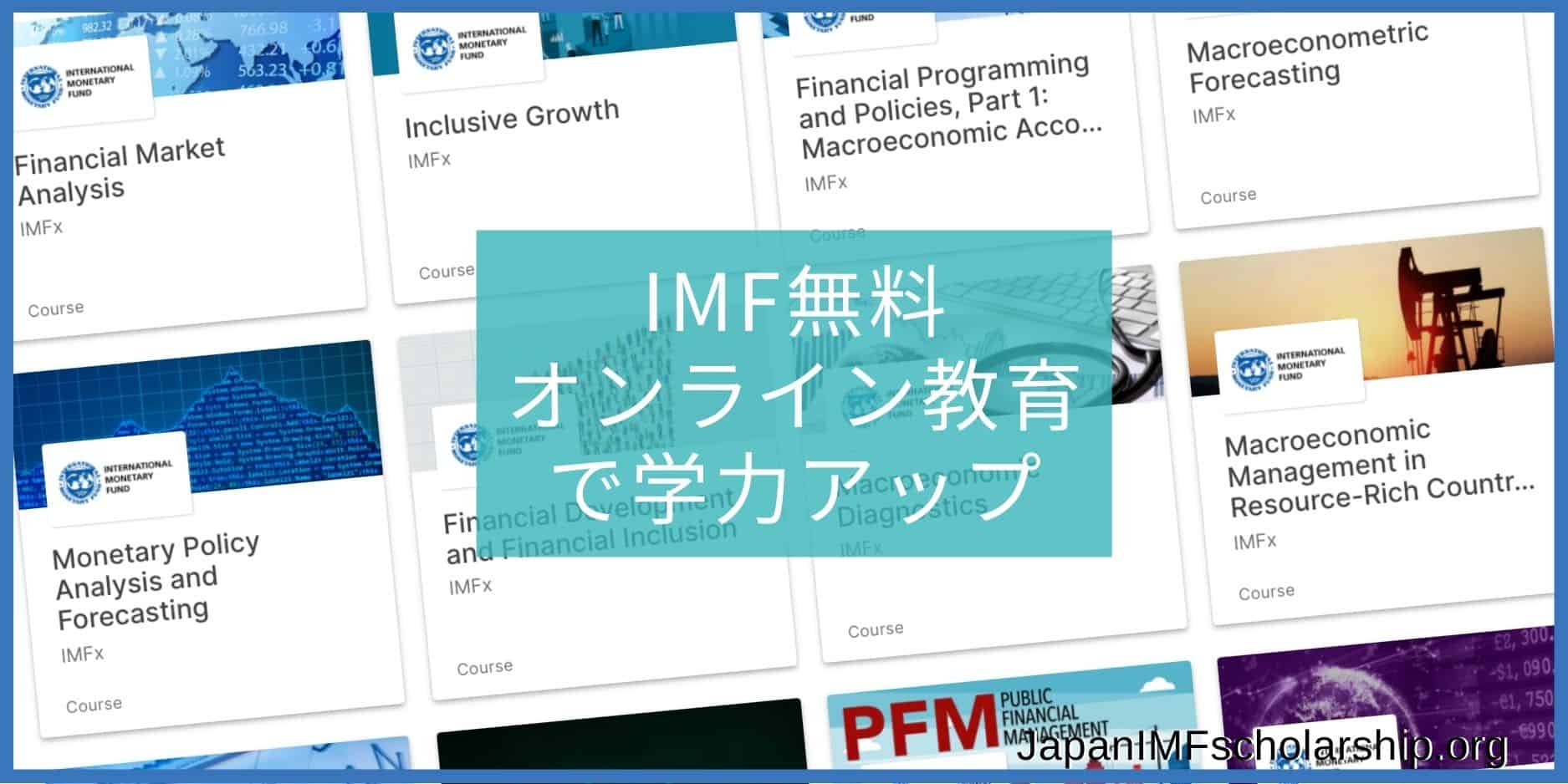
IMFの無料オンライン教育
経済学の勉強法としてIMFが無料で提供しているオンライン教育を紹介します。一つはedX(無料オンライン教育サービス)のサイト内にあるIMFx講座です。現在120以上の講座を用意しており、世界中から約20万人以上の方が受講しています。Wifi環境であればいつでもどこでも受講することができます。もう一つは、YoutubeにあるIMF Institute Learning Channelです。主に受講法ではなく視聴して学ぶ方法で動画を多様に用意しています。
edXってどんなサービス?
edXとは、無料のオンライン教育サービス(MOOC: Massive Open Online Course)の1つであり、たくさんの主要な企業や大学が、大学レベルの多数の分野の授業を無償で提供しています。学生はもちろん、教育を必要としているどなたでも受講可能です。インターネット環境内でしたら場所を選ばないので、自宅でも受講できます。
受講法の種類
- Audit Track:聴講法の無料コース
- Verified Track:インストラクターサポートや修了証などを含む有料コース
講座により有料コースの条件の違いがあります。
IMFx講座とは?
IMFxは日本政府が財政的支援をしているオンライン学習プログラムです。今現在、約120講座用意されています。
どのように受講するの?
IMFxはedXの「Economics and Finance」コース内で見つけることができます。
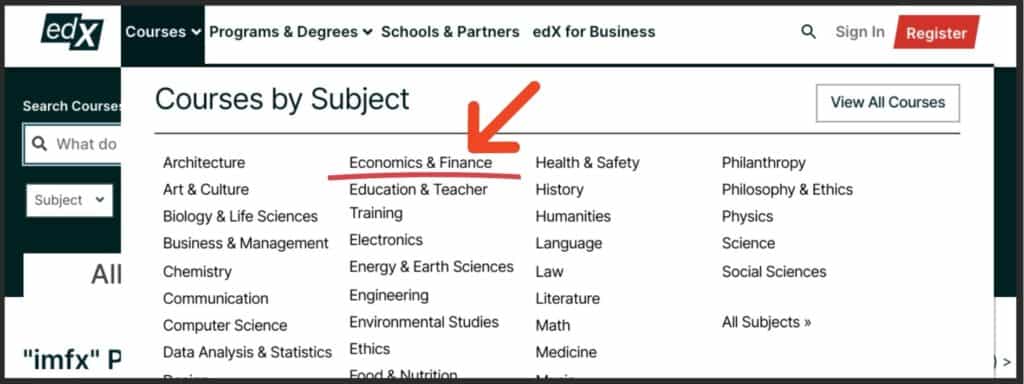
- 「Courses」をクリックするとコースの全カテゴリーが表示されます。
- 「Economics and Finance」をクリックすると関連する講座が表示されます。
もしくは、edX内でIMF、またはIMFxを入力し検索します。
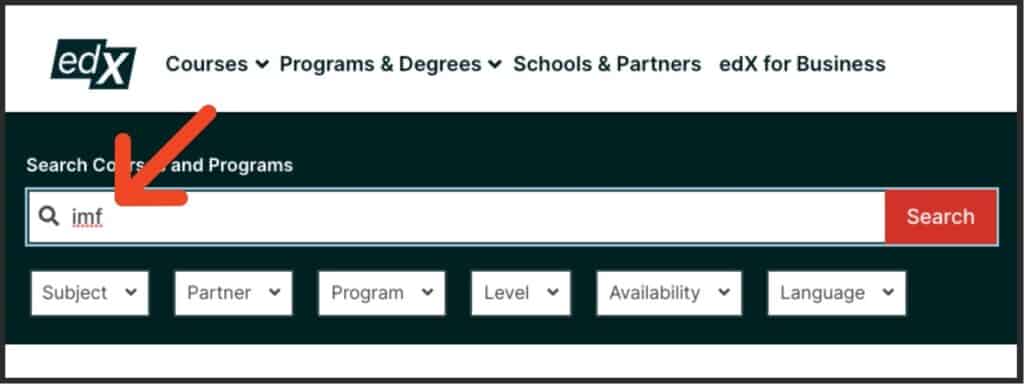
- 上記の検索部分にIMF,もしくはIMFxを入力し「Search」をクリックすると全IMFx講座が表示されます。
IMFx全てのコースはこちらから簡単にリンクできます。https://www.edx.org/search?q=imfx&tab=course
実際にIMFx講座を開いてみる
受講したいIMFx講座を開くと下記のように講座の情報が表示されます。(例としてFinancial Market Analysisを表示)
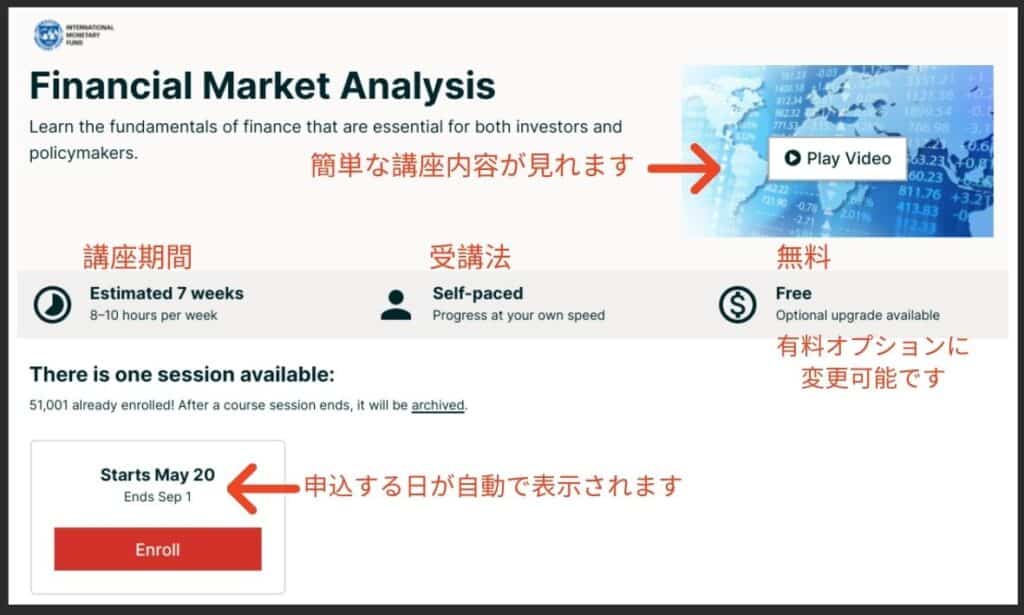
- 右上にある画像に再生マークがある場合はクリックすると簡単な講座内容が視聴できます。
- 講座期間(この講座の場合)の目安は週8~10時間の受講で7週間になります。
- 受講法の「Self-paced」とは、自分のペースで受講が可能となります。他に、インストラクターの指示で進む「Instructor-paced」の講座もあります。
- 無料講座から有料オプション(インストラクターサポートや修了証などを含む)に変更ができます。
- 申込みは左下の「Enroll」をクリックしてアカウントを作成し、受講へ進みます。
追加されたIMFx講座
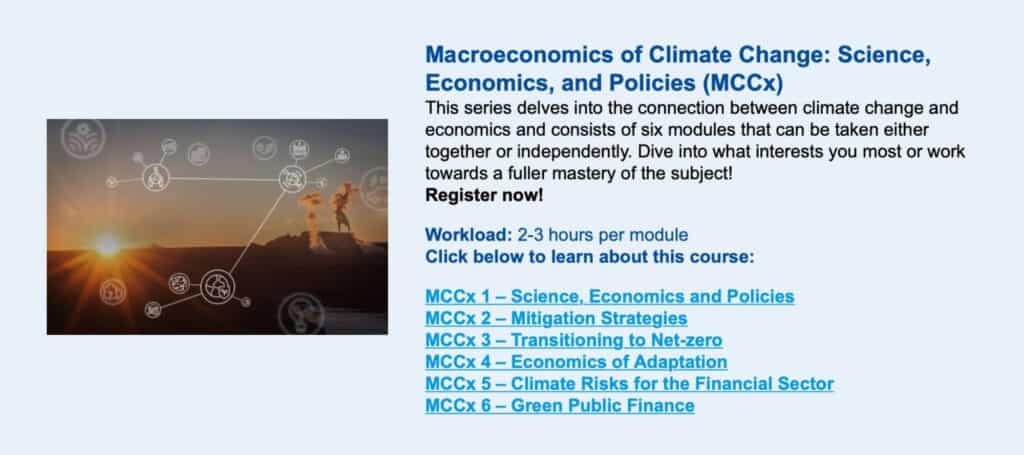
本コースについてこちらの動画をご覧ください。https://www.youtube.com/watch?v=zKQgbdYkvQA&t=5s
- MCCx 1: Science, Economics and Policies
- MCCx 2: Mitigation Strategies
- MCCx 3: Transitioning to Net-Zero
- MCCx 4: Economics of Adaptation
- MCCx 5: Climate Risks for the Financial Sector
- MCCx 6: Green Public Finance

<学ぶ内容>
- Analyze fundamental principles and trends in tax revenue analysis.
- Explain the key features of an effective institutional framework for revenue forecasting
- Identify data requirements and recognize potential data issues.
- Produce revenue forecasts using different methods.
- Recognize the strengths and limitations of different forecasting methods.
- Quantify the revenue impact of tax policy changes, using input-output tables and micro-simulation models.
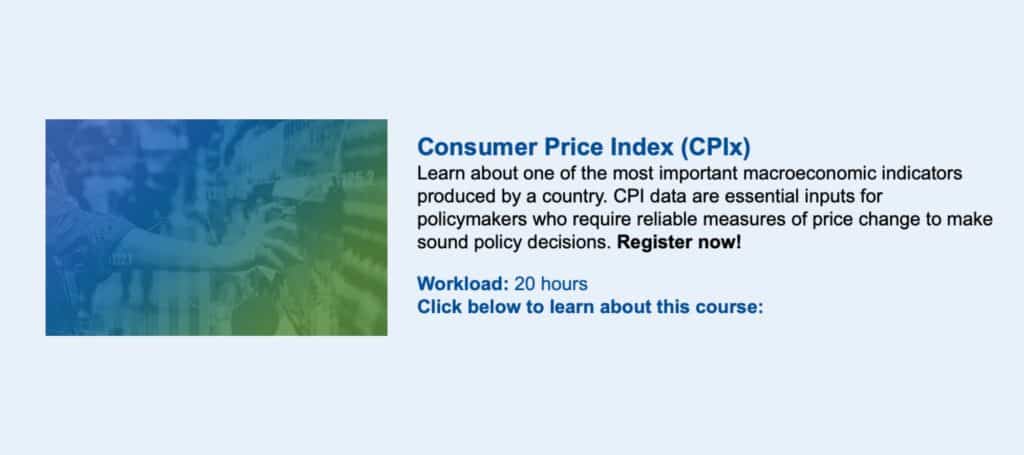
<学ぶ内容>
- Identify key uses of CPI data and explain key consumer price index concepts and definitions and how these are applied in practice.
- Identify and explain differences between the different index calculation formulas.
- Define and explain the different levels of sampling in a CPI and how these sampling methods are applied in practice.
- Identify and explain the different methods for the treatment of missing prices and describe how these are applied in practice.
- Introduce new CPI weights and link old and new indexes to create a continuous time series of data.
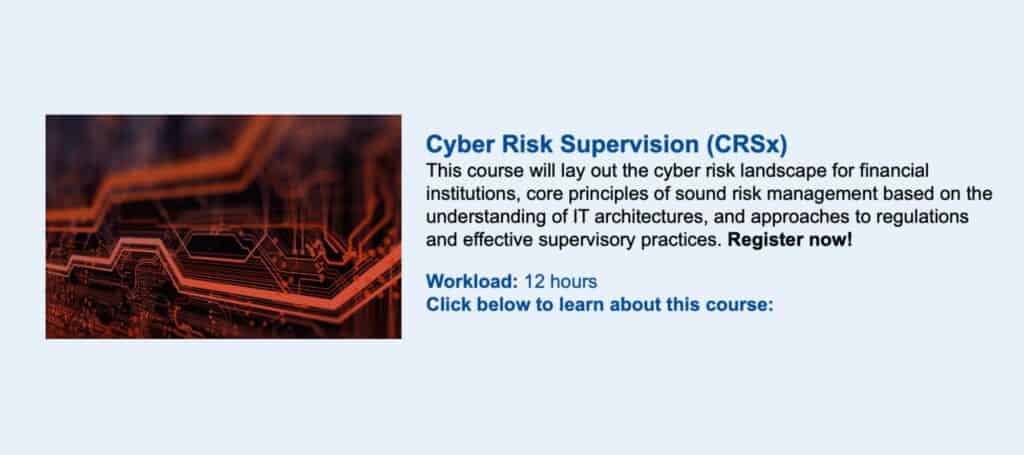
<学ぶ内容>
Upon completion of this course, participants should be able to: Demonstrate an understanding of the cyber threat landscape Identify key drivers of cyber risk Explain approaches to cyber risk management Assess risk management practices Understand the concepts in framing cyber risk regulations Learn elements of cyber risk supervision Identify key situations that require expert supervision.
その他のいくつかのIMFx講座を紹介
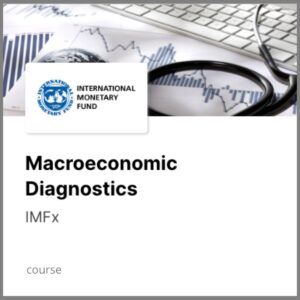
<学ぶ内容>
- How to analyze potential output and calculate output gaps, identify expenditure composition of growth, measure inflation, and assess sources of inflation
- How to assess the stance of monetary and fiscal policy and interpret financial sector soundness and risk indicators
- How to analyze public and external debt sustainability, analyze the external position, and evaluate possible exchange rate misalignment
- How to assess the medium–term prospects of the economy including the sustainability of public and external debt, and identify impediments to long–term growth
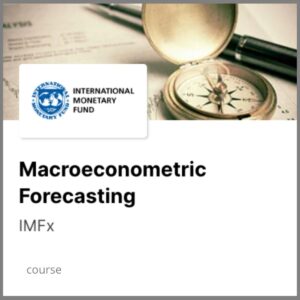
「Macroeconometric Forecasting」
<学ぶ内容>
- Evaluation of macroeconometric models
- Forecasting of uncertainty and forecasting for policy analysis
- Properties of time series data and model design
- Dynamic specification and the use of vector auto-regression models (VARs) and error correction models (VECMs)
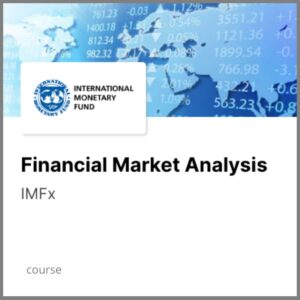
<学ぶ内容>
- Identify different types of basic fixed–income securities and the markets in which they are traded.
- How to price a variety of financial assets: money market instruments, bonds, and equities.
- How to measure and compare different yield measures for financial assets.
- Relate differences in the valuation of single equities or markets with economic fundamentals.
- How to construct an optimal portfolio of risky assets using historical return data, and assess likely changes in its composition as a result of changes in macroeconomic conditions.
- How to assess the market risk of an investment by calculating its Value at Risk (VaR), Stressed VaR, and Expected Shortfall.

「Compilation Basics for Macroeconomic Statistics」
<学ぶ内容>
- Differentiate institutional units and sectors
- Apply the concept of residence; Record in an integrated manner stocks and flows
- Apply appropriate accounting rules; Classify financial instruments
- Summarize the requirements and recommendations of the IMF’s Data Standards Initiatives
- and Evaluate macroeconomic inter-linkages.
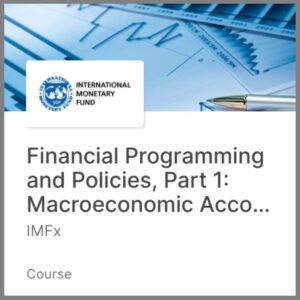
「Financial Programming and Policies, Part 1: Macroeconomic Accounts and Analysis」
<学ぶ内容>
- How to identify the four main sectors of an economy and understand the key linkages among them
- How to read, interpret, and analyze macroeconomic data
- How to identify macroeconomic imbalances
- How to retrieve data for your own country and analyze it

「Balance of Payments and International Investment Position Statistics」
<学ぶ内容>
- Explain the framework of the balance of payments and IIP and relevant indicators, such as the current, capital, and financial accounts balances.
- Apply core concepts and definitions relevant to the international accounts such as residence, economic territory, predominant center of economic interest, and accounting rules.
- Classify cross-border transactions and positions according to the BPM6.
- Record the main components of balance of payments and IIP.
- Explain the direct investment framework and its role in the economy, including as a source of financing.
- Compare the different functional categories and understand the economic interpretation for each category.
- Recognize the need for integration of the balance of payments with the IIP for producing consistent and coherent data.
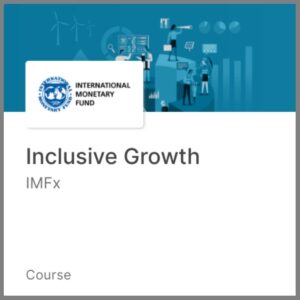
「Inclusive Growth」
<学ぶ内容>
- Define the concept of inclusive growth and its many dimensions, and establish the links between growth, inequality, and poverty.
- Develop a framework to holistically analyze inclusive growth issues and prioritize policy actions.
- Measure inclusive growth in a country using a wide range of indicators, including indicators of poverty and inequality.
- Explain the role of fiscal policy in supporting inclusive growth and highlight best practices for designing tax policies and expenditure programs to foster inclusion.
- Describe what makes a labor market inclusive and examine determinants of labor market outcomes.
- Design labor market policies, including tackling informality and labor market disruptions from technological change.
- Analyze gender inequality and its negative economic implications.
- Identify why good governance is important for inclusive growth and summarize the policies to improve it.
- Identify the key risks to sustainable and inclusive growth related to climate change and design a policy mix to address climate change mitigation and adaptation while cultivating inclusion.
IMF Institute Learning Channelとは?
様々な分野でYoutubeが活用されているのは皆さんもご存知かと思います。IMFも経済学の勉強に役に立つ動画を揃え、IMF Institute Learning ChannelとしてYoutubeに掲載しています。チャンネル登録をすると新しくアップロードされた動画のお知らせも通知されます。
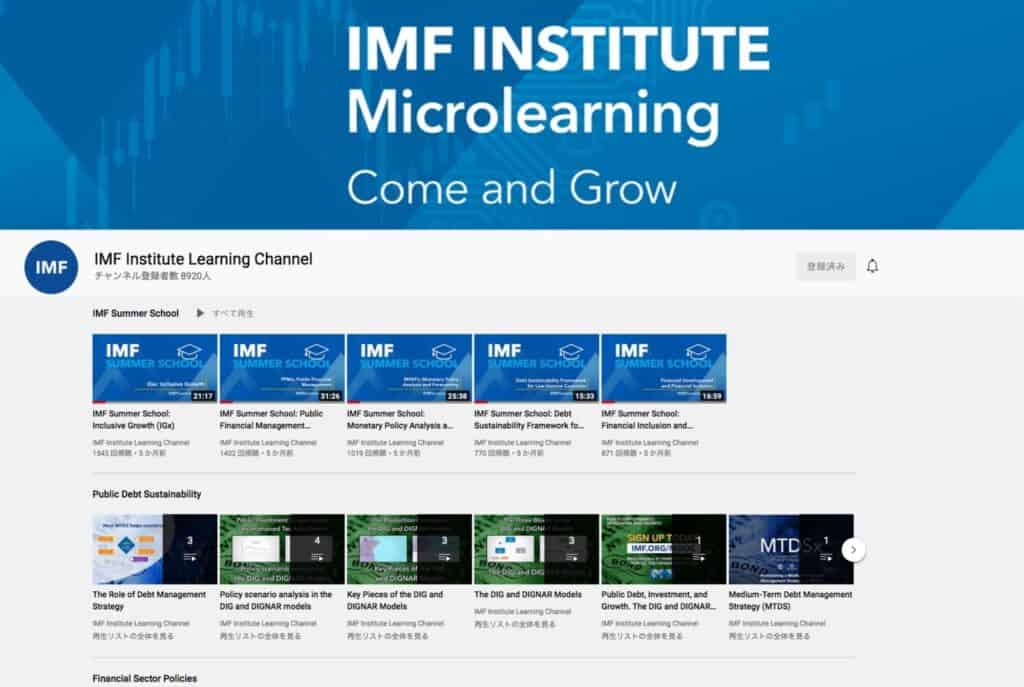
チャンネル内のいくつかの分野を紹介
IMF Summer School(2025年度)
- Debt Management, Debt Reporting and Investor Relations (DMIR)
- Monetary and Financial Statistics (MFSx)
- Institutional Sector Accounts (ISAx)
- VITARA-Audit (VITARA-AUD)
IMF Summer School(2024年度)
- Quarterly National Accounts and High-Frequency Indicators of Economic Activity (QNA)
- Financial Soundness Indicators (FSI)
- VITARA-Performance Management (VITARA-PMG)
- Macroeconomics of Climate Change: Mitigation Strategies (MCC-MS)
IMF Summer School(2022年度)
- Virtual Training to Advance Revenue Administration (VITARA)
- Medium-Term Debt Management Strategy (MTDSx)
- Macroeconomics of Climate Change (MCCx)
- Consumer Price Index (CPIx)
IMF Summer School (2021年度)
- Inclusive Growth (IGx) さらに学びたい方はこちらへ
- Public Financial Management (PFMx)
- Monetary Policy Analysis and Forecasting (MPAFx)
- Financial Inclusion and Financial Development (FDFIx)
- Debt Sustainability Framework for Low Income Countries (LIC DSFx)
その他
動画は主に英語で作成されています。「話し方が早過ぎて追いついていけない」、「今何て言ったの?」などといった場合は、一時停止や巻き戻しが可能なので何度も視聴し直せます。また、英語の字幕や音声スピードを設定することもできるので、英語勉強法の強化にもつながります。
また、IMFのチャンネルではIMFの活動内容をはじめ、世界経済に関わるたくさんの情報が配信されています。そもそもIMFは世界経済にどのように関わっているのかが学べます。https://www.youtube.com/user/imf
IMFの無料オンライン学習はIMFエコノミストを目指している方、また経済学に興味がある方などにおすすめの勉強法です。世界に通じる経済学力と英語力を強化するためにチャレンジしてみましょう。
IMFオンライン教育は日本政府が支援しているプログラムです。
なお、この投稿は2023年2月2日に投稿された記事のアップデートです。
Japan-IMF奨学金制度についてご質問等ございましたら、よくある質問ページをご覧ください!
